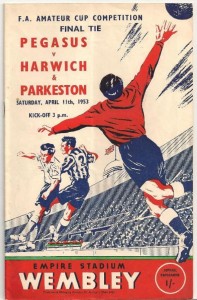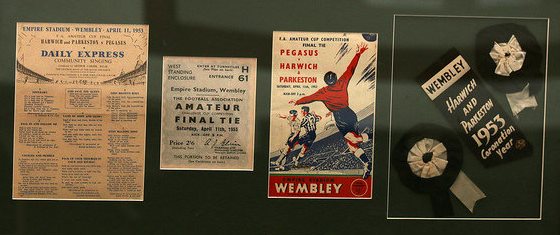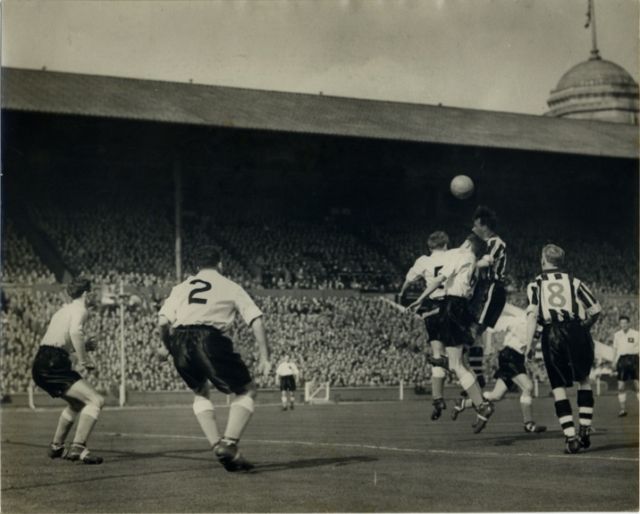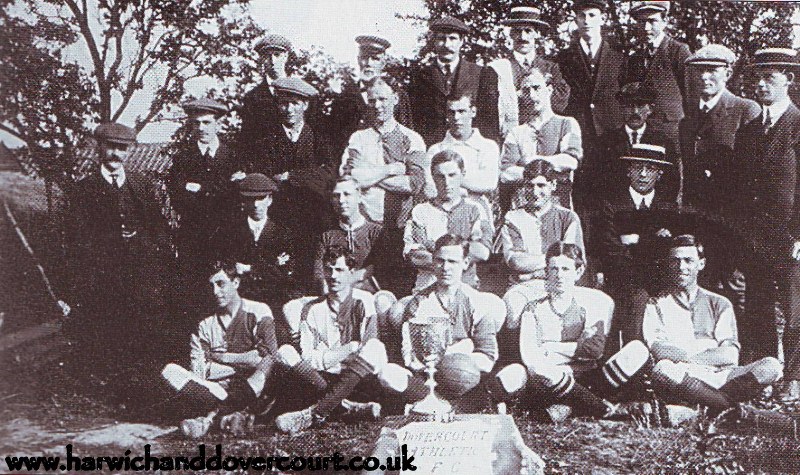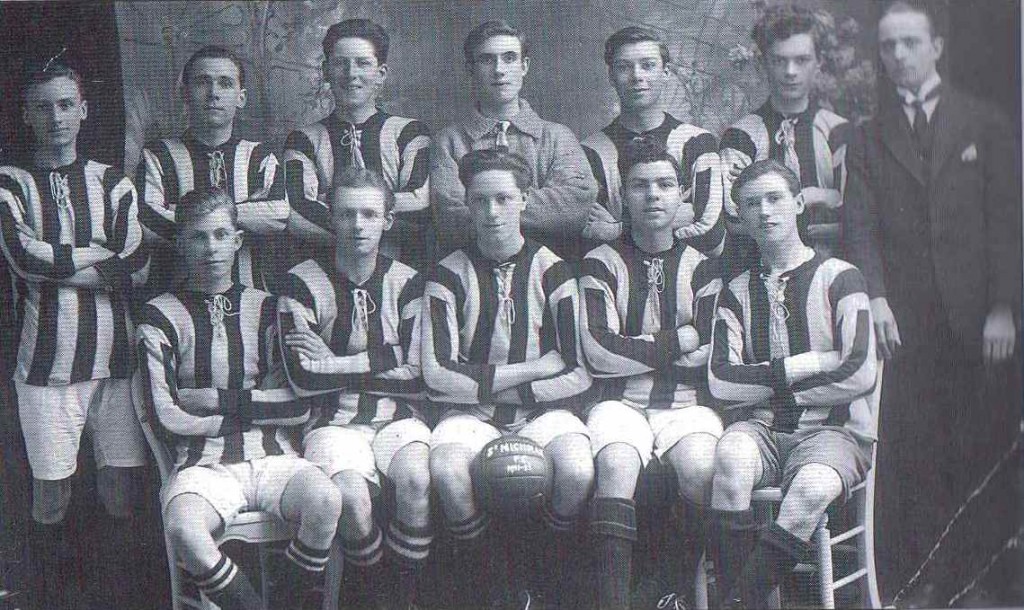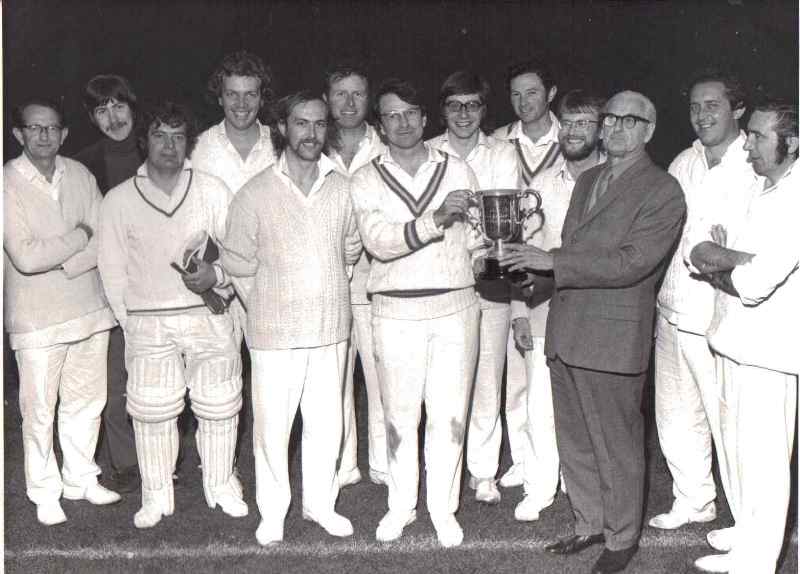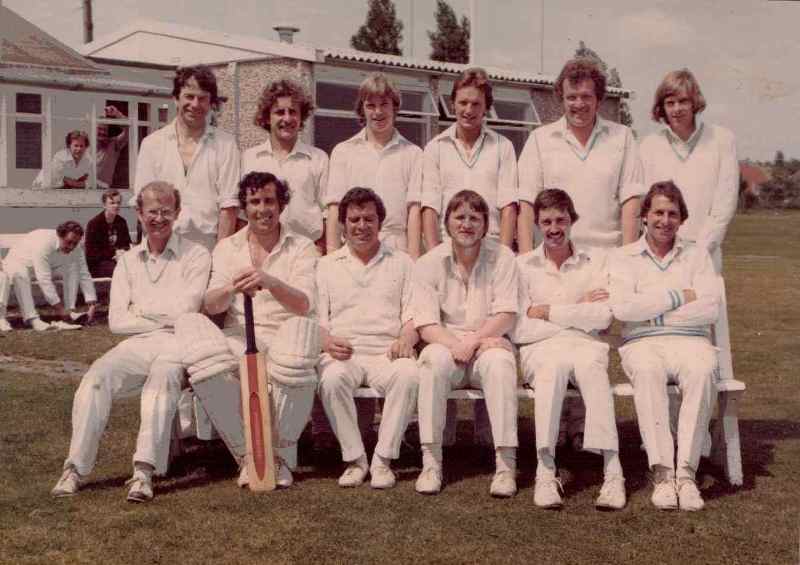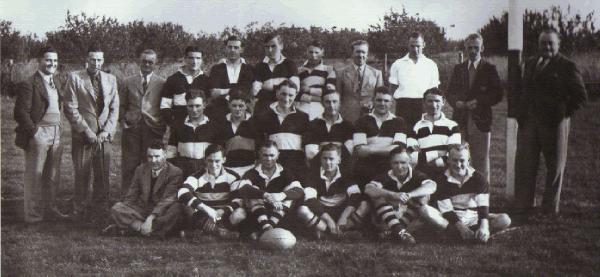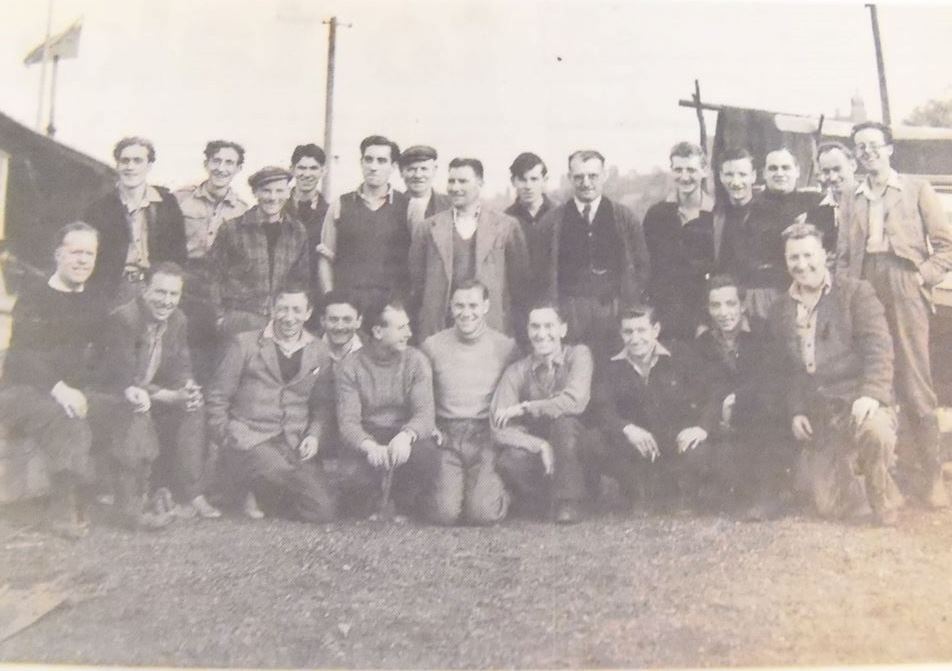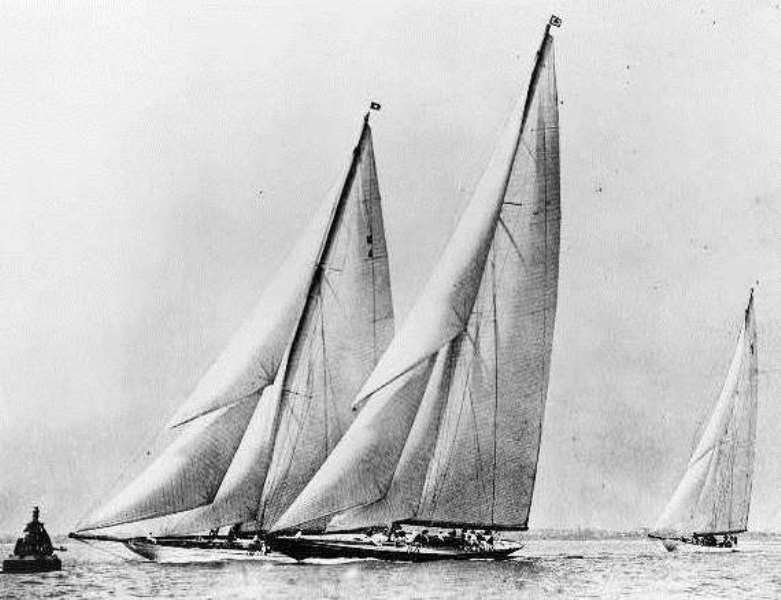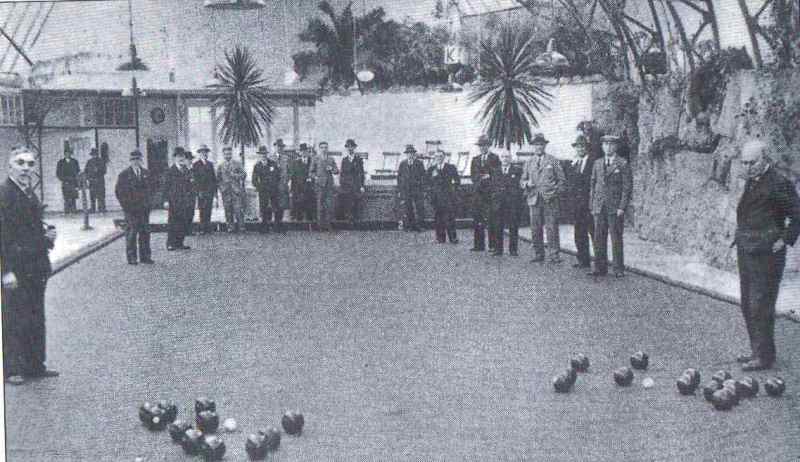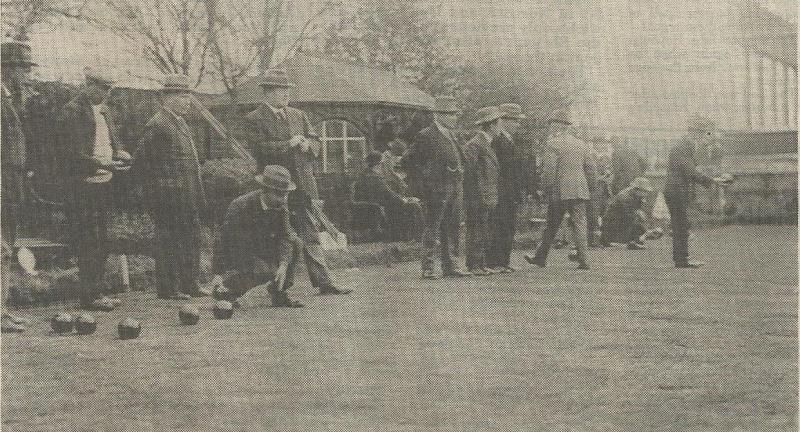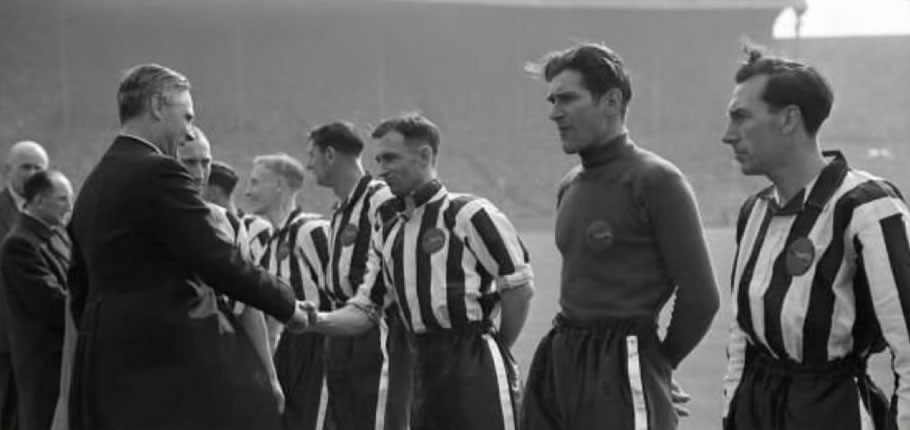
Sport and Leisure
Sport was one of the main sources of entertainment for many people and there were a large number of local Football teams, especially with the number of sailors and soldiers who were based in the town.
Many sporting activities were available – bowls could be indulged in ‘on the pretty green adjoining the Hotel Alexandra’, fishing from the pier or, if preferred, a night out with one of the Bawleys could be arranged. Visitors could shoot curlew, duck and plover along the marshes, sail up the Orwell or hire a rowing boat from Dovercourt pier. Alternatively, there was tennis swimming and walking and cycling to Colchester, Clacton, Brightlingsea and Bures.
Rivalry between all the pubs provided its form of pleasurable competition with every pub having a quoits and darts team, every establishment hoping to top the ‘league tables’ at one or the other sports.
Football.
Harwich & Parkeston F.C
Harwich and Parkeston F.C. has a long tradition dating back to 1877, when the football club was founded,Popularly known as the “Shrimpers” they chose claret and blue as their colours and had as their original ground, a plot overlooking the sea! near the Phoenix hotel, the site was not particularly satisfactory, for much time had to be spent fishing footballs out of the sea!.
The first recorded game was away to Dedham Grammar School in November 1877 when they were defeated 6-0 in a friendly game.
During that time it has gained many friends and admirers. In 1898 the club moved to the present ground the Royal Oak, at that time the ground was called Wix meadow because it belonged to the vicar of Wix. they would also change their colours to their present stripes.
The shrimpers have enjoyed an illustrious history – reaching national finals, winning regional and county cups and league titles, In 1890-91 the Shrimpers began to find their feet and played six Essex Senior Cup games to reach the final only to lose 7-0 to Clapton.
Harwich were soon carving out a reputation as a formidable amateur side, reaching the final of the FA Amateur cup in 1899. They made the long trip to Middlesbrough, where they were edged out 1-0 by Stockton. the match was played at Linthorpe Road Middlesbrough being a neutral ground, on March 25th 1899 with a crowd of over 7000 spectators.
Team: Fred Kettle, G Bacon, George Howard, Bob Ingham, Frank Garton, G.Whitehead, W.Garland, Eley Harwood, Fred Taylor, Archibald Snodgrass.
Stockton were on top for most of the game but the winning goal do did not come until one minute from full time. Billy Fairbairn followed up after Billy Bryons free kick had hit the post and rebounded to him.
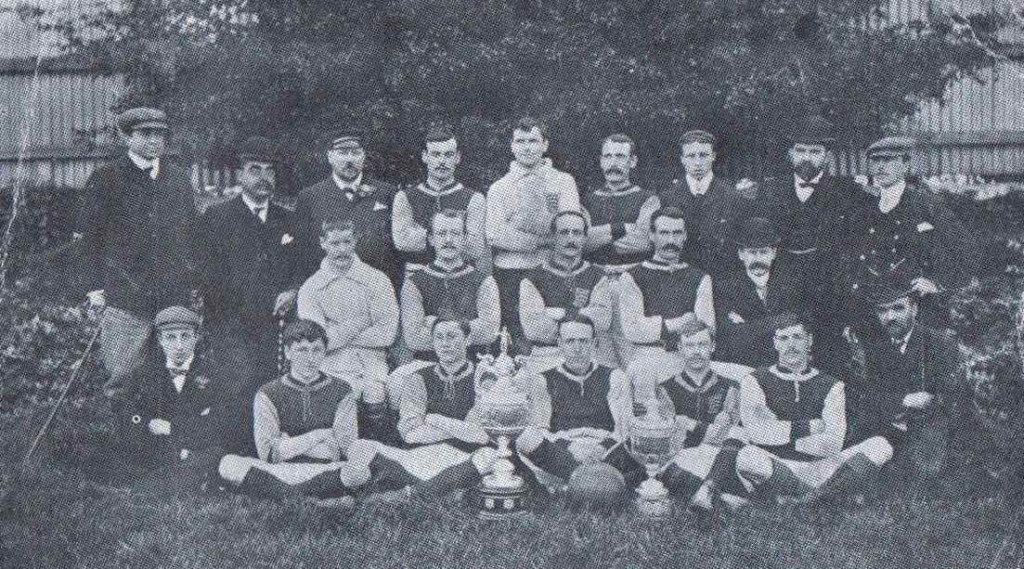
Harwich and Parkeston FC 1903
Proudly displaying the two trophies they won in 1903 are members of Harwich and Parkeston Football Club. The Harwich team. Kettle, Oswick, Fielden, Green, Garton, Garland, Middleton, Lyons, Snodgrass, Felgate and Taylor. They defeated Chelmsford 2-0 at Colchester in front of a crowd of 1,800. A large enthusiastic crowd met the team of the train when they returned to Dovercourt where they went on to the Queen’s hotel – their headquarters, and later the Alma where the cup was filled with champagne, and finally they went on a grand tour of the streets of the borough. The following week they added the Harwich charity cup when they defeated Colchester crown 2-0. Victories over Ipswich and the cold stream guards respectively had resulted in the two teams contesting the final. The trophy was presented to Harwich captain F.Kettle, by the mayor Alderman Everard.
The 1930’s represented halcyon days for the Shrimpers as they were also joint champions with Lowestoft in the first season of the Jewson League 1935-36. They were also the first ever winners of the ECL Cup. Harwich joined the eastern counties leagues in 1935, during the 1930’s they reached the 1st round proper of the F.A. Cup. “THE OAK” saw a record attendance of 5649 spectators in an amateur cup quarter final defeat against Romford in 1938.
Harwich hit the big time in 1934 when they reached the first round proper of the FA Cup for the first time and were drawn away to Bristol Rovers to lose 3-1.
The Road to Wembley
Harwich played eight games en route to Wembley, including a memorable semi-final victory against Walton and Hersham at Brentford.
First Round.
- Harwich & Parkeston 4, Whitton United 2
- Second Round
- Harwich & Parkeston 3, Harrogate 2
- Third Round
- Harwich & Parkeston 2, Clevedon 1
- Fourth Round
- Harwich & Parkeston 4, Leytonstone 3
- Semi Final
- Harwich & Parkeston 3, Walton & H 1 (At Brentford)
Harwich at Wembley
Just one year after celebrating their 75th anniversary, Harwich and Parkeston are at Wembley, and back in the flood-battered East Anglian coastal area, the folk still cannot realise such an occurrence is true. At the start of the season they had little more than dim memories of intermittent hours of glory, and yet, here they are, proudly gracing the emerald green turf of the finest Football stadium in England with their black and-white striped shirts. Three special trains, sixty coaches and hundreds of cars headed for north London in the biggest-ever exodus the area had known. Injury robbed the team of centre half Freddie Lane, but the club, players and officials we’re taking their appearance on football’s centre stage in their stride. “We are treating it just like another cup-tie” said trainer-coach ‘Bill Layton.
1953 Cup Final Team
- Bill Layton, Coach
-
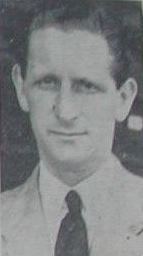
Bill Layton
- Bill Layton’s granddad was English amateur international George Layton, who wore his shin-pads outside his socks and played for Birmingham in the day when they were known as Small Heath. Bill was 22 when he became a pro with Reading. The War interrupted his career bit in 1945, after a successful trial, he was reserve for England against Wales at Cardiff. In those days Bill rubbed shoulders with stars like Mortensen, Matthews, Mercer, Lawton and Franklin. A year after the England game Bill was transferred to Bradford Park Avenue for £ 6,500. Three years later agreed to move to Colchester, who then had big hopes of becoming a Football League club. He was nearly 40 when United were finally admitted to the Football League in 1950. In 1951 Bill was given a free transfer after making over 50 first team appearances.
He then joined Harwich as player-manager and in three years met with a good deal of success, the trip to Wembley in the Amateur Cup final undoubtedly being the highlight. However, the club decided not to retain his services at the end of the 53/54 season, and Eric Armstrong was appointed his successor. Bill quit football to concentrate on running his pub the Garland Hotel at Parkeston.
- Bert King, Goalkeeper
- Aged 31, “Joe”- as he is known served with the Royal Air Force in Egypt and Palestine during the War, like all his team mates, had not experienced the Wembley atmosphere before.
- Basil Nightingale, Right Back
- Aged 29, this sturdy, tall defender is one of those who joined the club on its restart after the war, a dock porter, and his work has built up his physique, also served during the war in the Middle East.
- Eric Tyrrell, Left Back, (Capt.)
- Aged 28, Eric captains the team, and is the quiet, but nevertheless inspiring type of leader. Eric was an electrician and served in the motor torpedo boat section of the Royal Navy during the war.
- Peter Christie, Right Half
- Great hearted player who fractured a cheekbone in the semi-final against Walton, but wanted to play again the following week. worked as a milkman in Colchester and completed his round before joining the team.
- Ken Bloss ,Centre Half
- Ken was born in Stanford-le-Hope and moved to Dovercourt at a young age, Ken worked for the local Electricity board and was also Captain of Harwich and Dovercourt Cricket Club.
- Robert Haugh, Left Half
- Few teams can do without a hard working Scotsman, he signed for the club in 1947-8 after playing for a junior team over the border. Robert was employed by Clacton council and served in the army during the war.
- Bert Stremp, Outside Right
- Polish born, Bert came to England in 1945, and joined Redhill, moving onto Harwich in 1951-2. Bert was employed as a warehouseman and served with the Polish forces in the 8th army.
- Stan Pearson, Inside Right
- Aged 28, Possessor of a famous football name, he joined the club in 1952, and soon provided his true worth. Stan’s finest season with Harwich was undoubtedly “Wembley Year” when his speed and opportunism in front of goal made him a continual menace to harassed defenders, Even in the final Stan was one of the few “Shrimpers” players to enhance his reputation. Stan was picked three times for Essex. He came to Harwich from Parkeston Railway in Bill Layton first year as trainer coach at Harwich, and he almost immediately gained a first team place.
- David Davies, Centre Forward
- Aged 20, Born in Wales, and previously played for Kenfig Hill Juniors before being taken on Leyton Orient’s Ground Staff.
- Ron Cooper, Inside Left
- Aged 27, Ron hailed from the Midlands, and went to Harwich from Villa combination in 1947-9 whom he joined after demob from the R.A.F., a family man who hoped to provide a winner’s medal for his recently arrived child. Ron was employed as a building operative.
- Victor Jennings, Outside Left
- Aged 30, A grand utility man, is learning fist the intricacies of wing forward play, and can be depended upon not to fail the club at their most vital hour. Victor was a shipping clerk and also served in The R.A.F. during the war.
100,000 spectators packed out Wembley Stadium to watch the Shrimpers play against Pegasus, a combined university side from Oxford and Cambridge. Harwich, having been devastated earlier in the year by floods, needed a boost and a trip to Wembley was just what was needed. Harwich are an unusual side, for they have two permit players for their Eastern Counties league matches and the pair are not eligible for Amateur Cup matches 8,000 tickets were sold locally, 3 special trains laid on and some 60 coaches were also provided to convey the supporters to the ground, having beaten Whitton United, Harrogate, Clevedon, Leytonstone and Walton & Hersham the players and supporters had a trip to Wembley to look forward to.
Rosettes, pennants and woolly hats were made in the black and white colours of the club, leaving the towns shops sold out of ribbon! A queue formed at the Royal Oak and tickets sold out. Ticket prices started at 2/6d for a standing ticket and went up to 12s. for seated. Six special coach services and three steam train special services ran to take everyone to London and thunder flashes were placed on the railway tracks as part of the celebrations as the train’s left Dovercourt station. Along the route at Kelvedon one supporter’s family stood on the railway embankment waving black and white pom-poms to fans on the train, who waved back enthusiastically. The stage was set for the greatest day in the club’s history.
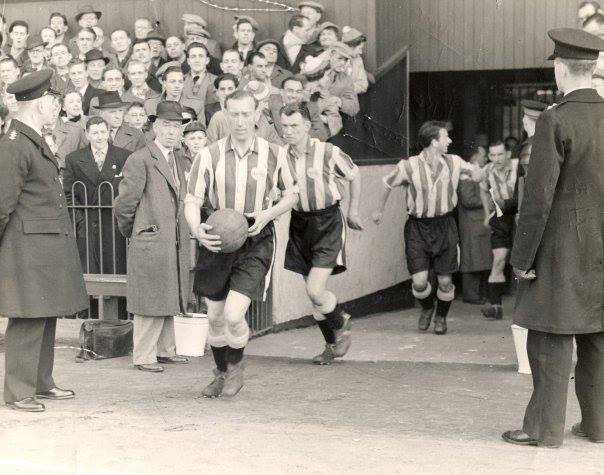
Harwich & Parkeston 1953
Lining up in the tunnel were the two teams side by side, with captains Eric Tyrell for Harwich & Parkeston and DF Saunders for the Pegasus team ready to lead their teams out into the 100,000 packed out stadium. Harwich & Parkeston had a great supporting crowd which needed special transport to the stadium by trains and coaches to cater for the thousands of supporters which wanted to go. The game started off with Saunders winning the toss and then both sides showed flair and determination, but the Pegasus team started to dominate, especially with Lunn the inside left.
The first goal was a result of Lunn,s elastic dribbling which produced a corner and from that Dennis Saunders out jumped the Harwich defence and headed the ball in the back of the net.
Five minutes later Sutcliffe made it 2-0 and the Pegasus were flying high. The third goal was scored by a low drive from Carr and then two more goals by Laybourne and Sutcliffe before the final goal was scored by Carr to complete a 6-0 victory.
Skipper Recalls.
There were a few nerves but, more than anything, i was just excited it was such a special occasion the sort of thing every footballer dreams of and I’ll Never forget the wall of noise when we walked out before kick-off. There were so many people and the atmosphere was incredible.
We were so well supported and people said Harwich was deserted, because Everyone was at Wembley.” Two of their goals were on the lucky side and I’m Convinced the final score would have been different if we’d had our centre half Freddie Lane, available. Harwich were all over Pegasus in the first 15 minutes, the ball fell to Taffy Davies near the penalty spot but he couldn’t get a shot in. We were better than that and everyone played well. We were disappointed but still enjoyed our day and the reception that followed at the town Hall that evening.
Although Harwich & Parkeston were beaten on the day, the skill which they had used to get them to the final will never be forgotten.
In 1964 Harwich joined the Athenian League, Gaining Promotion in Two Years to the Premier Division, by 1965 they had appeared in three more F.A. Cup 1st round properties against Headington, Crystal Palace and Torquay United.
The black and white stripes of the Royal Oak Boys landed the league cup again in 1997,in a storming season that also saw them finish thirds in the league.
In 1973 they switched to the Isthmian League. In 1976/77 they again reached the 1st round proper of the F.A. Cup, Losing to Enfield In a home replay. The early 1980s saw a decline in Harwich’s fortunes, being twice relegated. After a season in the Athenian League they returned after 20 years absence to the Eastern counties league.
The Essex senior trophy was lifted in 1990 and a year later they reached the Quarter final of the F.A. Vase. In 1996/97 they won the Essex counties league cup.
In 2003 Joe Royle, Ipswich town manager, and Jack Hayward, Essex county F.A. President, opened, the new board room and dressing room facilities. Despite a late rally from manager Mitchell Springett Harwich were relegated at the end of the season.
Tribute must be made to all who sacrifice their time,energies and often money, in order to help Harwich and Parkeston F.C.
Dovercourt Athletic Football Club.
1912-1913 was a momentous season for the players and committee of the Dovercourt Athletic football club, The end of season provided a thrilling finish when Harwich and Parkeston reserves and Dovercourt athletic finished on equal points. Harwich and Parkeston won the play-off By 3 goals to 2 on Dovercourt’s home ground in upper Dovercourt. Having seen Harwich Presented with the trophy and medals.
Dovercourt lodged a complaint with the league committee concerning a match against Walton where Harwich had been awarded points, Although the game had not been played.
The appeal was upheld and the athletic players were awarded the shield and medals instead.
St. Nicholas Football Team
This picture shows the St Nicholas Football Team, posing in the studio around 1921-1922. The team members are. R Rundle, J Lord, R Nightingale, J Rowland, H Kedge, R Cotton, A Goody (hon secretary) on the back row. Seated In front are C A Mallows, L Smith, F Kettle (capt) C Closs and E Keeble.
Cricket.
Harwich & Dovercourt Cricket Club
Harwich and Dovercourt cricket club was formed in 1967 when Dovercourt amalgamated with Parkeston railway cricket club. at the time Dovercourt playing on the low road in Dovercourt, were struggling to raise teams due to lack of players.
Parkeston railway had no difficulty in raising a team, but were faced with confiscation of their Hamilton Park ground due to impending development. Stan delves (secretary of the railways side) with Brian rich (secretary of Dovercourt cc) met in Barclays bank where Brian rich was the manager, to formulate the merger, and put the idea to their respective committees.
Both clubs had members who opposed to the merger, but these were in the minority, and Subsequently both committees met in a room over the bank to merge the clubs.
When the 1967 cricket season started there were a few members on both sides refusing to play. however the newly formed club started their season and have since gone on to playing mainly league cricket. Harwich and Dovercourt cricket club look to be close to achieving their aim of having new Changing rooms completed by the beginning of the 1995 season. and it’s all thanks to hard work by a small band of dedicated club members and the generosity of Harwich Town Council and Stena Sealink line. The club house has been completely refurbished with the help of free artexing.
Rugby.
Harwich and Dovercourt Rugby Club
Harwich & Dovercourt Rugby Club was formed in 1936 by a group of local gentlemen; an article appeared in several local papers in September of 1936 inviting anybody interested to attended a meeting “at which the real business of the formation of the new club would be discussed”. Lieut. Col. H.M.A Ward was elected president and Dr..K..Phelan chairman.
The clubs Headquarters was the old Alexandra hotel and the matches were played on Shaftesbury camp ground. Concern was expressed that the formation of such a club would be in opposition to the soccer clubs in the town, and assurances were given that this would not be the case and by the end of the first season these fears were proved to be groundless.
The first season proved to be quite successful for the club, the record shows played 18 won 8 lost 9 drawn 1 point for 175 against 145.
It is interesting to note that many of the original clubs that Harwich played in the first season still have fixtures with the club. Following the reforming of the in 1961 and what proved to be difficult years in the late sixties due to the continual movement away from the town of more experienced players owing to the nature of their employment, the club has gone from strength to strength, main due to the introduction of rugby at the Harwich school. The club has been able to capitalise on this and are now in the fortunate position of being able to turn out three senior sides most weeks. The club games and training now takes place on the low road playing fields.
Tennis.
Tennis always seemed to be a popular sport locally and the players were well catered for. There were the hillcrest courts in Brooklyn road, those attached to the Alexandra hotel and Parkeston players had courts in Hamilton Park. The Dovercourt Sports club, established by 1912 had 7 courts, May 1913 saw the 2nd open Tennis Championships with the press commenting that “the 7 courts have been practically re-laid since last year”.
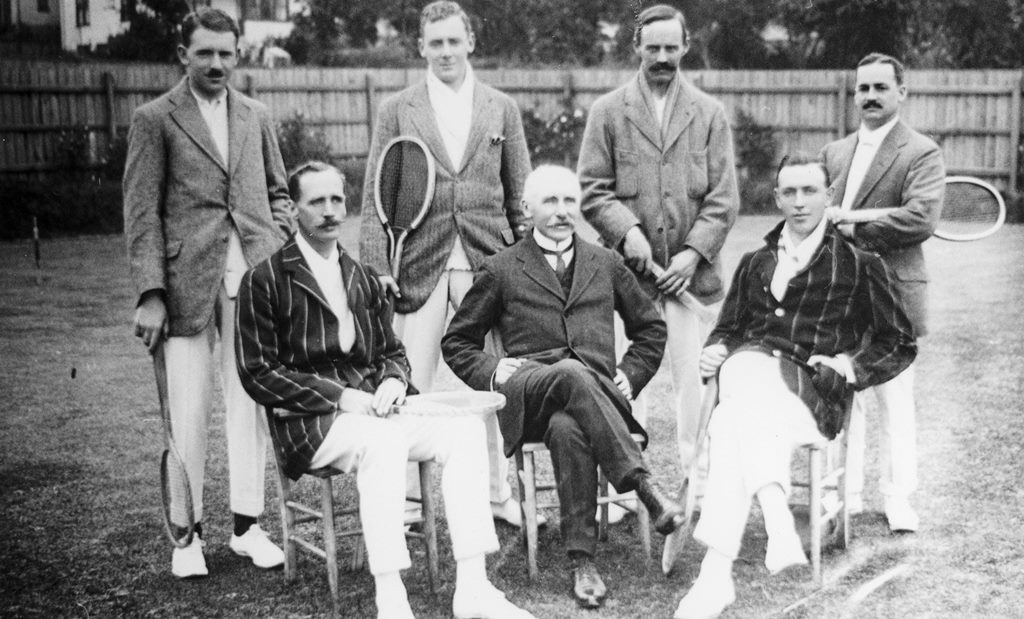
Dovercourt Tennis Club
The courts were deemed to be in beautiful condition for hard and fast play.
In 1923 the council contracted En Tout Cas to lay three hard courts on Harwich green and 3 hard courts in Dovercourt almost opposite the yacht pond.
Moto-Ball.
Played with a 15-inch leather ball and five players per side there were regular matches on the Yeast factory sports field. At one time there were ten teams playing in the British League. Shortly after the end of World War II a group of recently demobbed servicemen formed a Motorcycle Club in the town, naming it the ‘Stour Valley MCC’, and soon became well known in the Eastern Centre of the ACU for its Grass Track Meetings. During the early sixties, a group of local teenagers with their BSA Bantams, Triumph Tiger Cubs, Francis Barnetts and the like attended a motorcycle maintenance class at the Grange, the local further education centre.
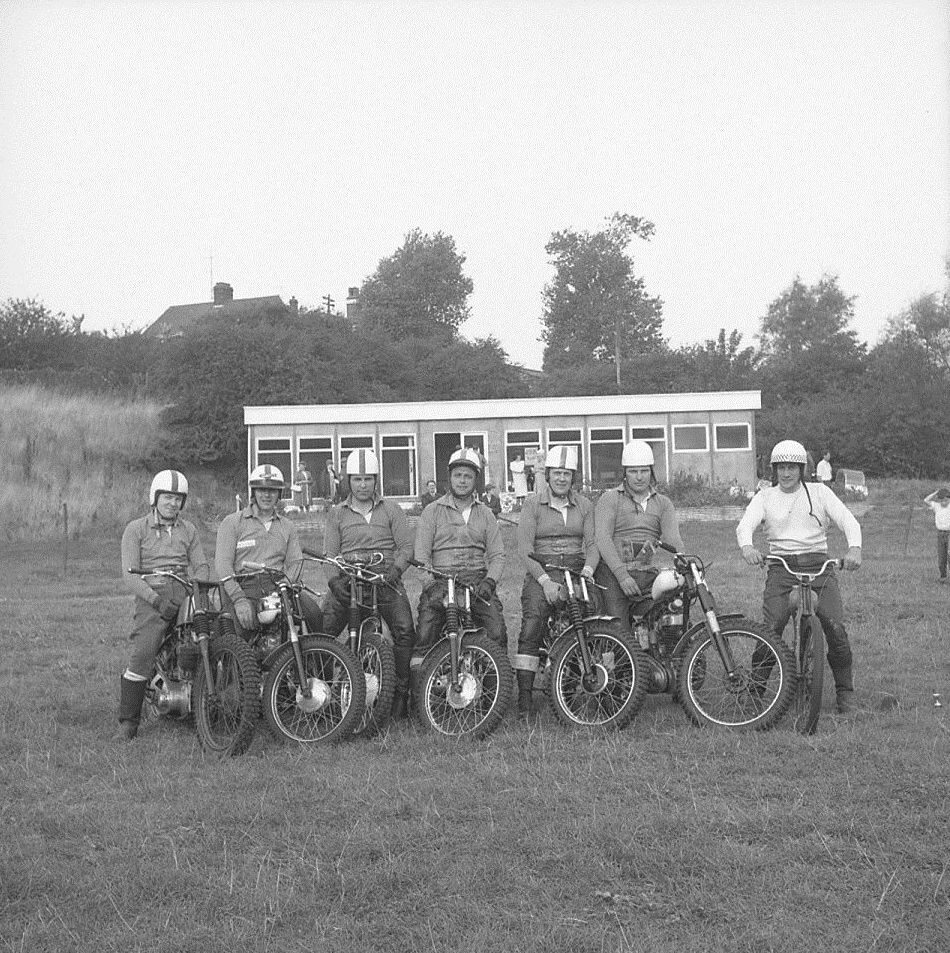
Moto-ball
Their tutor was a fellow enthusiast and local car mechanic John Mowle. During these classes with John’s encouragement these lads decided to form a Motorcycle Club.
A meeting was called in March 1964 at the Bird in Hand Public House, around thirty riders attended, and so the club was formed, John Mowle was elected Chairman, and Peter Goodwin was elected Secretary.
The club at this time was fortunate to have a member working at the Yeast Factory, and the club were able to use the social club as their HQ and the sports field for Motoball, this tenure lasted for many years.
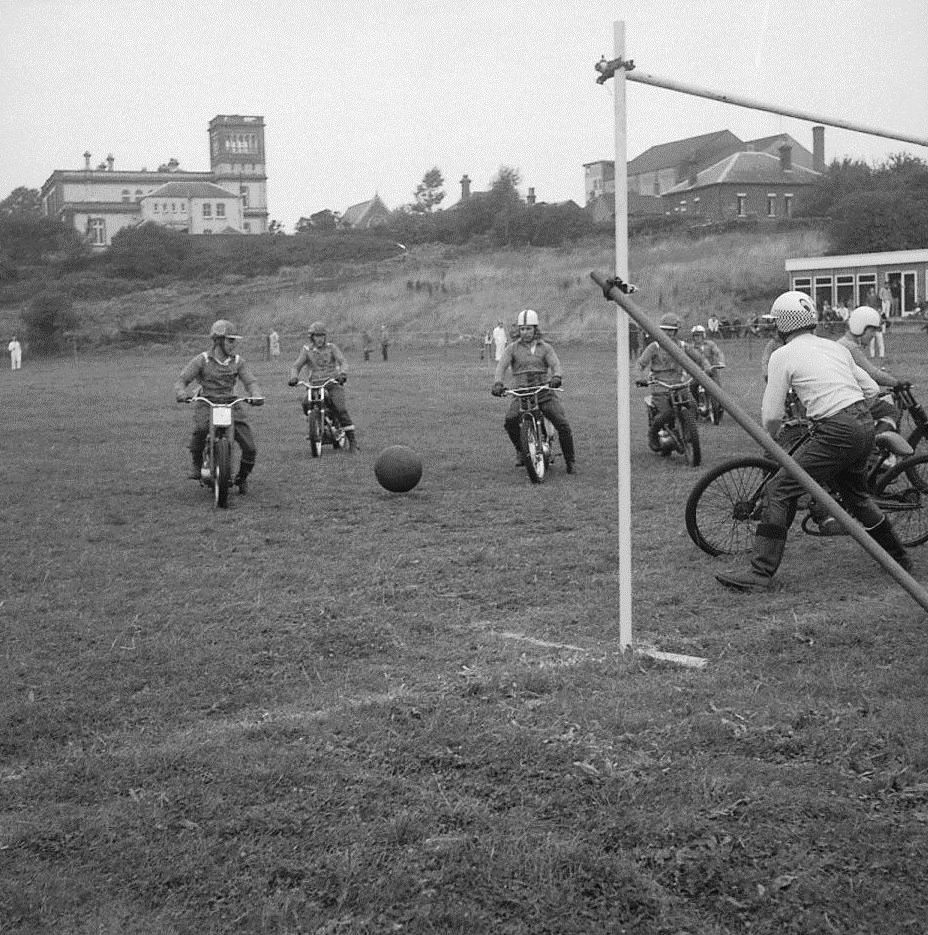
Moto-Ball 1965
The Motoball team after learning their trade at various fetes joined the British Motoball League travelling to teams such as Border, Alton, West Herts, Metropolitan Police and Triangle staging home games at their HQ and at Warner’s Holiday Camp. Eager to gain further experience the team travelled with Triangle to Holland to face Dutch teams, the sport being very popular in Europe. Later they travelled to France to represent England in the European Championships, and in 1982 the ultimate achievement being invited by the Russian Federation to send a team to the Soviet Union to compete in the Championships being held in Poltava near Kiev.
Whilst all this was happening, the club was still active across the wider spectrum of motorcycling, the name was changed to Harwich MCC, a youth section was formed which provided the club with a young nucleus of trials riders, some of whom became top riders in their own right winning championships throughout the region.
Tragedy struck the club in March 1986 with the destruction by fire during the night of their club house, although treated as arson no culprit was ever apprehended. The loss was devastating with the loss of trophies, mementoes and photographs being lost. After this the club went into decline for a short time, a few stalwarts keeping the club alive, meeting at wherever possible. Eventually a move to the Community Centre at the ‘Park Pavilion’ revived the club’s fortunes and in 1989 the club celebrated their 25th Anniversary with a party, inviting old members and guests from the friends that the club had made throughout those years.
New members and the return of old members during the nineties have revived the club’s fortunes again.
Quoits.
The history of quoits is disputed. One theory often expressed is that the sport evolved as a formalized version of horseshoes, which is a sport that involves pitching a horseshoe at a spike in the ground. A more likely explanation, however, is that horseshoes evolved from the sport of quoits, which in turn has its origins in ancient Greece. Whilst the first quoits were apparently made from horseshoes, in the context of the game’s evolution the significant point is that they were initially closed to form a ring and used in their open form only after the practice of pitching at a spike had been established.
Drunkenness, violence and ‘bad characters’ were some of the more unsavoury aspects of the many pubs in the area. But a more peaceful rivalry came from the sporting activities of the various pub teams.
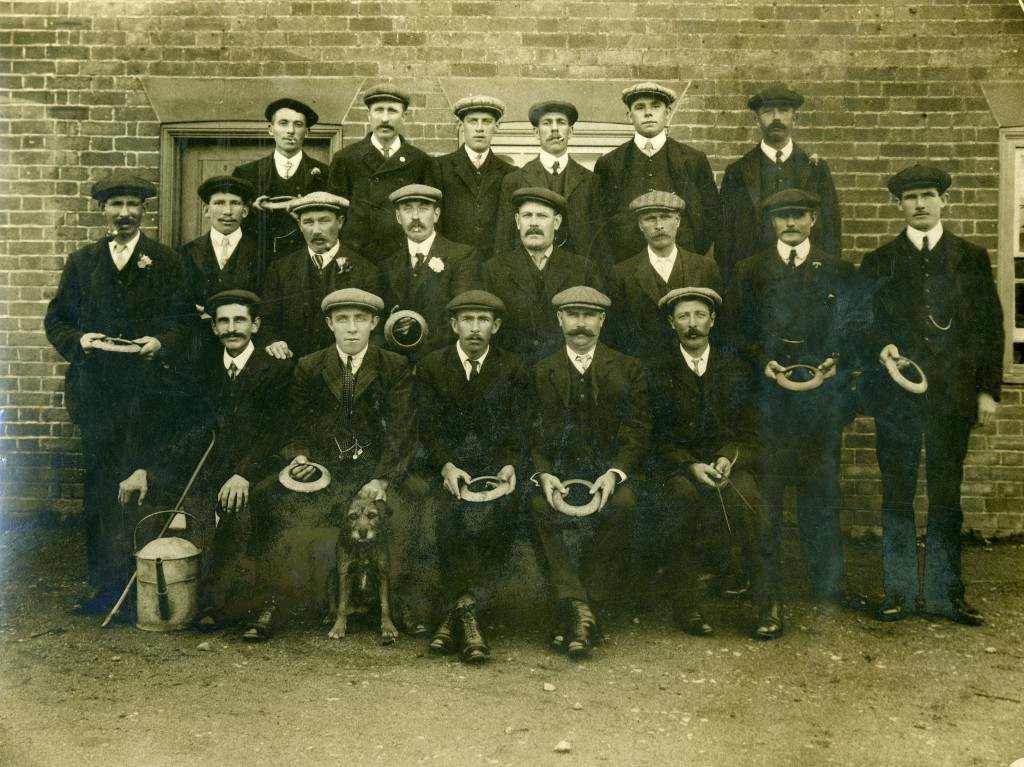
Lord Nelson Quoits Team
In England quoits became so popular that it was prohibited by Edward III and Richard II to encourage archery. Despite this setback, by the 15th century there is evidence that it had become a well-organized sport, not least because of the numerous attempts to eradicate it from the pubs and taverns of England owing to its apparently seedy character.
The popularity of the game during the 19th and early 20th centuries also gave rise to several variants, usually with the aim of allowing the game (or a version of it) to be played indoors or making it accessible to women and children. Games such as ringtoss or hoopla became popular as parlour games, whilst versions such as indoor quoits allowed pubs and taverns to maintain their quoits teams through the winter months.
To the casual onlooker the game of Quoits is an easy one, but to disabuse that theory let the pure novice endeavour to pitch a 7lb circle of steel on to a bed of clay some 21 yards away.
On the Anchor Rover ground fronting the Anchor hotel the tournament was organised by the Harwich and District Association. 12 hours of keenly contested games. 400 people paid to witness the competition in addition to the 90 competitors.
Roller Skating.
Exciting international roller hockey match, the first to be staged at Dovercourt, was a feature of the programme presented by Dovercourt Roller Hockey Club on the Dovercourt rink, on Saturday August 27th 1966.
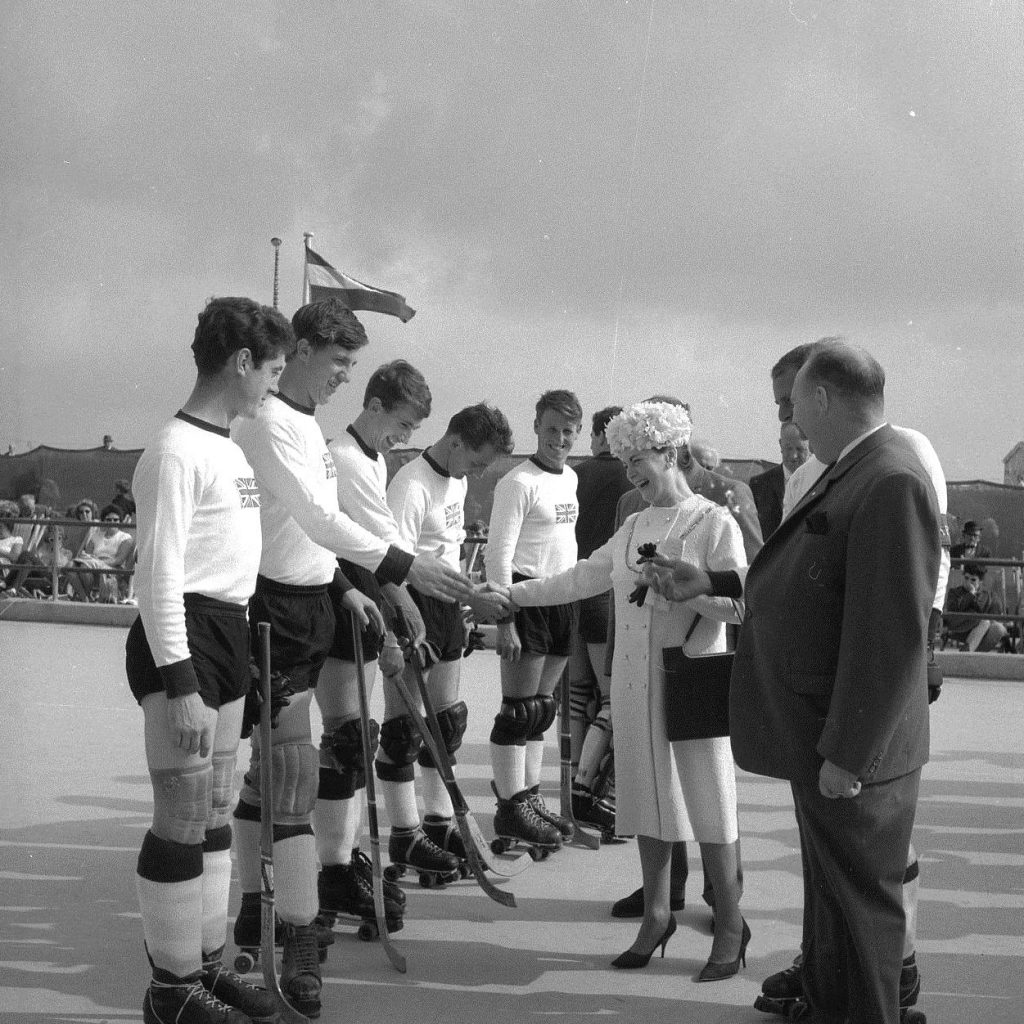
England v Holland
The high-speed game between England Holland resulted in a 4-4 draw, the first time the teams had met since Holland won in the world games in Brazil in May. Prior to the match a lunch was held in honour of the Dutch team at Phoenix Hotel. Guests included the Mayor and Mayoress, Councillor and Mrs L.E. Hostler, and Ald. E. Grant, president of the Dovercourt Roller Hockey Club, and Mrs Gant. Holland got the first goal after about ten minutes of the first half, and the second came a few minutes afterwards. Then England scored their first through A. Cattee, of Rochester. Holland were leading 2-1 at half- time, but England caught up again in the second half.
Ten minutes before the end it was 4-3 for Holland, then five minutes away from the final whistle B. Galloway, of Wolverhampton, scored a fine equaliser.
Golf.
The Harwich & Dovercourt Golf Club was first formed in 1906, and is a 9 hole members club situated between the villages of Dovercourt and Parkeston. Two reverend gentlemen enquired as to whether the Club would be available for play on the Sabbath. Upon being answered in the affirmative, they straightaway announced their objections, and asserted that should golf be allowed to be played on a Sunday, then others would soon be playing football, or even quoits, on the Lord’s Day, which would lead to all sorts of mischief. Notwithstanding this highly principled opposition, the Harwich and Dovercourt Golf Club was inaugurated, and was set up on thirty acres of the Garland Estate in Parkeston over which land golf has been played ever since.
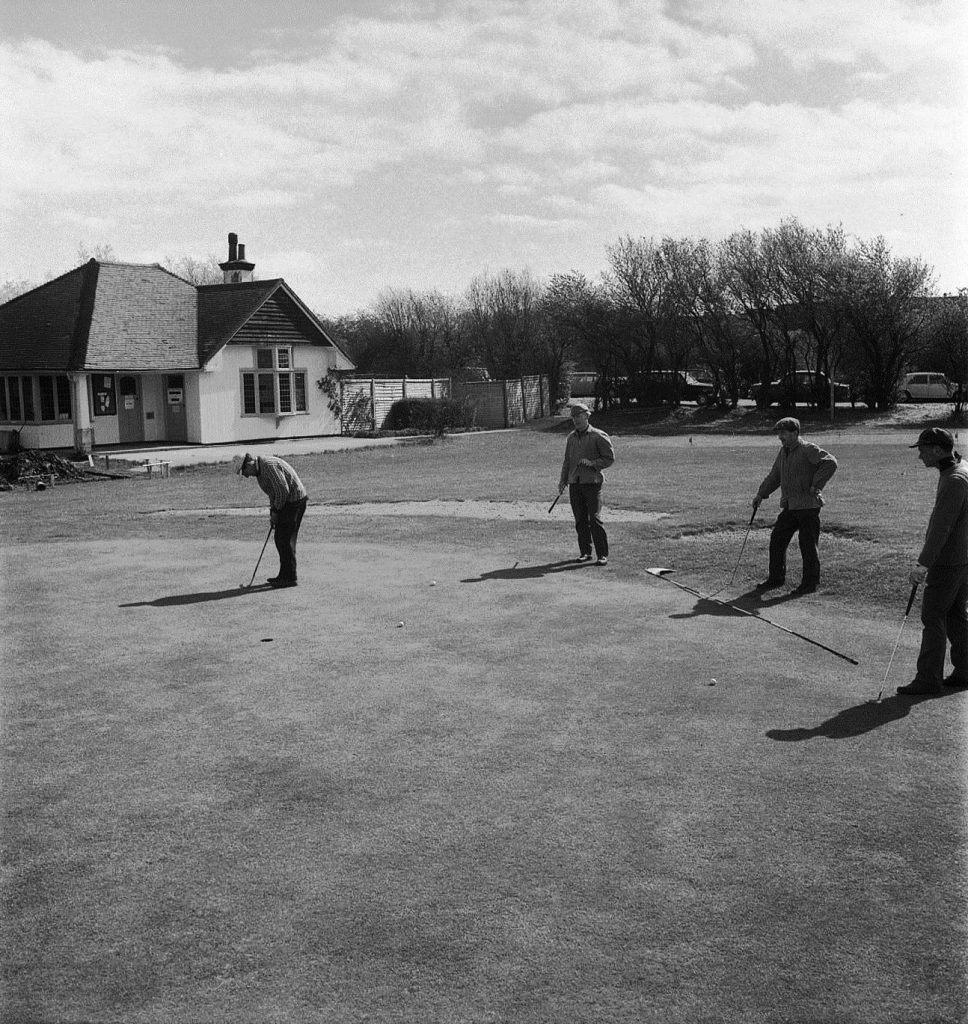
Golf
The Ladies of the Club decided to form their own section and, under the first Ladies Captain, Mrs A.Lucas, this happened in 1930.
At the onset of the Second World War the club was requisitioned by the army, and became part of the anti-invasion area, with a line of tank traps, which stretched from the River Stour, right across the peninsular, to the sea. This line of tank traps went right across the golf course.
Pillboxes were also built on the course, one of which is still prominent immediately behind the seventh tee. The end of hostilities saw the army withdraw, and the Club was handed back to its members who carried out a considerable amount of reconstruction to reinstate the course.
There were no facilities apart from the course itself, and soon, in 1912, the original clubhouse was built at a cost of £150.
The Club celebrated its 50th anniversary in 1956 at which time there were 50 Gentlemen members, 26 Lady Members, as well as a few Junior and County members.
After leasing the club land for fifty eight years, the freehold was offered to the Club. The purchase of the land was overseen by Captain of the day, Lewis Crickmore and was achieved at a figure of £1500 in March 1964.
Two years later, in 1966, it was decided to build a new Clubhouse. This project was initially introduced by the Captain Bill Stubbles and put to the members at a special; meeting on 23rd November 1966.
The cost of the construction of the Clubhouse was £5022, and it was officially opened on 28th October 1967.
Sailing.
Harwich & Dovercourt Sailing Club
It is believed that a “Harwich and Dovercourt Sailing Club” first came into existence in 1907 and continued for several years based on Dovercourt sea front. Unfortunately, there is no evidence as to when or why this club lapsed.
On the 14th July 1927 a meeting was held at Mr W. Garland’s Workshop (Kindly lent to hold meetings) for the purpose of those interested in Yachting to form a club. A Mr W Gay (Who was subsequently elected Commodore) took the chair pro tem and officers were elected. It was proposed and seconded that the club be called “Harwich and Dovercourt Yachting Club” At a meeting held on 22nd September 1927 it was decided that the title “Sailing Club” was more suitable than “Yachting” and the name changed. The club can rightly claim to be the oldest on the River Stour.
An arrangement was made with the LNER (London and North Eastern Railway) for use of Phoenix Quay in Bathside Bay, originally constructed for use by sailing barges and accessed via Patrick’s Lane. Subsequently a shed for storage was also rented. The Club’s relationship with the railways was cemented at a later stage by the affiliation with GEAAA (Great Eastern Amateur Athletic Association), which ceased with the nationalisation of the railways.
In 1933 a contract to build a club house on the quay was awarded to Mr C.W.J. Lewis for the sum of 52.10s.6d. This same building was moved onto a concrete barge in 1949, subsequently extended and continues to serve as the club house to this day. (Concrete barges were built during both the first and second world wars primarily for the conveyance of stores and water. Our barge was a World War II water barge. It is believed to have been moored locally and used to supply eater for the Harwich based Destroyer Flotilla).
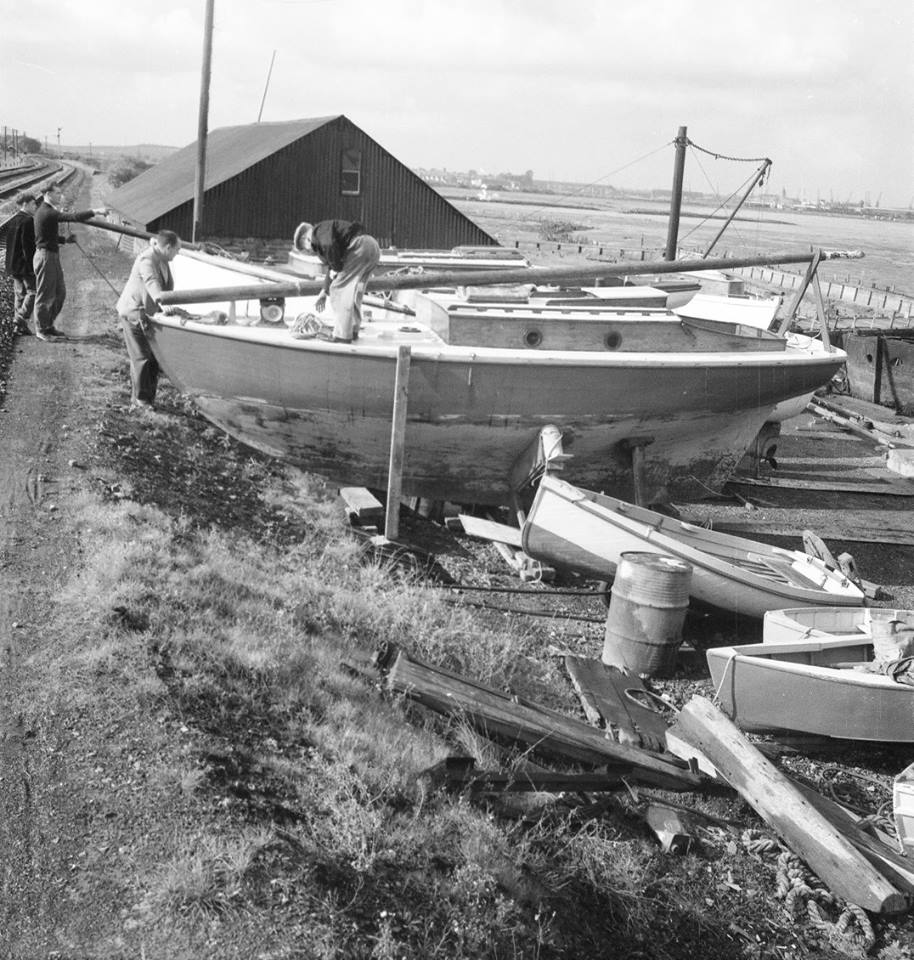
Phoenix Wharf (1960)
World War II saw the club’s silver being placed in the bank for safe keeping and all the boats being towed to the area around Manningtree and Brantham for safe keeping. all club activities were suspended for the duration and the Military took over the Club’s Quay and facilities. The flood in January 1953 left a trail of devastation on the quay, 34 boats were damaged, and nine were lost. Despite this it is understood that members got some small boats operational and went to assist the rescue of many people from their homes in Old Harwich and Bathside. In January 1985 the Club was required to move from its established location at Phoenix Quay, to enable to A120 road bypass scheme to be completed, which now encompasses Bathside Bay.
The present location in Gas House Creek, on a site formerly owned by Sea Containers Ltd. and now owned by Hutchinson International Ports is permanent, following the successful negotiation of a long-term lease. In 1982 the club had around 150 members and some 80 boats plus tenders. As part of the 75th Anniversary celebrations, then Commodore Frank Wellington said “At its inception and following the war the Club was very heavily committed to racing and the Harwich Regatta activities.
Harwich Town Sailing Club
In the nineteen fifties it became possible to easily own a dinghy. Build yourself designs proliferated so that wherever there was a bit of sailable water, sailing clubs were formed to exploit it, Harwich was an ideal place for this exploitation. The local town council caught on to this and had a ramp constructed to enable small boats to be launched from the Harwich beach. They also fenced off an area adjacent to the beach for a boat park.
The scene was set to form a dinghy club, so at an initial meeting organised by John Lovely and John Dedman in late 1960 the consensus was to go ahead. As the established local sailing club had neither the facilities, nor the interest to cater for racing dinghies, the way was clear to for a new club, the Harwich Town Sailing Club to be formed and it started accepting members in February 1961.
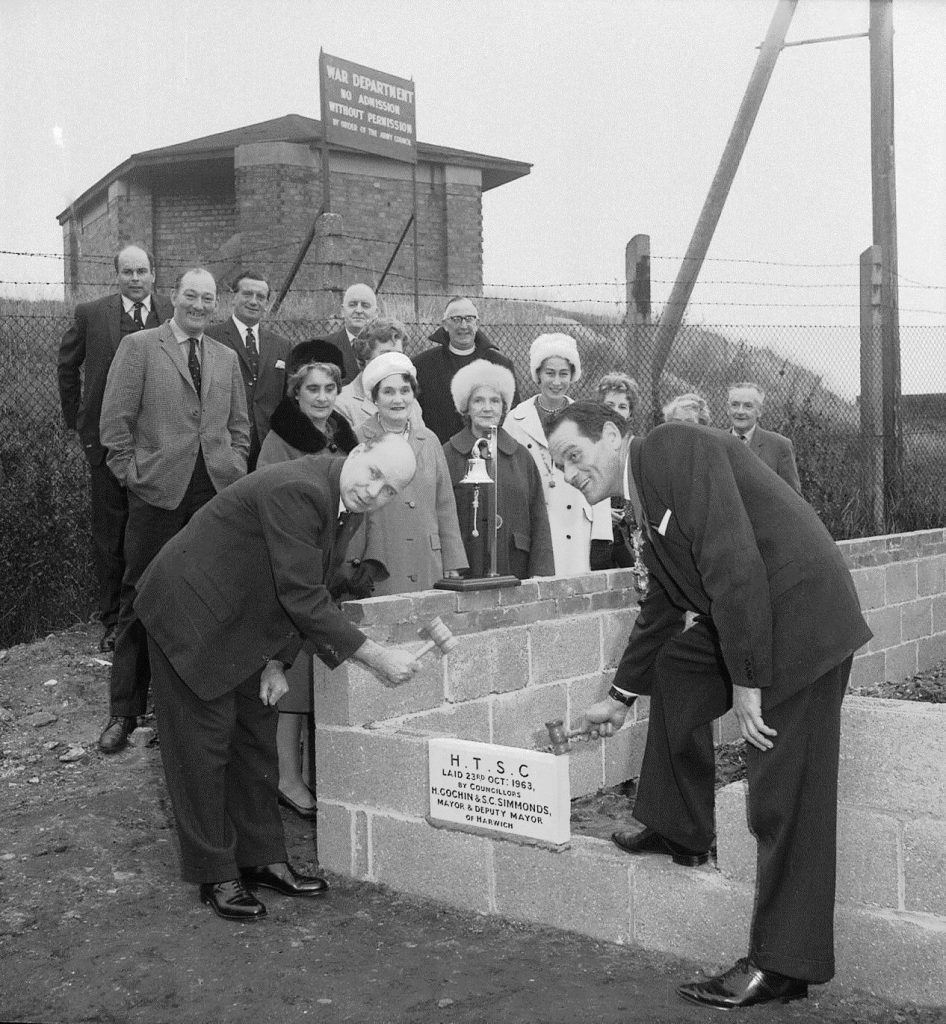
Foundation Stone 1963
The local council was very supportive and made available, an old building in Kings Quay Street, which had been a school amongst other things, as the first clubhouse. This was superseded by a new building on the promenade two years later, built by the members. It has had a couple of extensions since but still remains the headquarters with superb harbour views, close to the boat park and launching ramp. Initially the main class of dinghy being sailed was the Enterprise, with a few Cherubs and Ospreys however over the years this has changed mainly to the ubiquitous Laser and for a while catamarans. There are also a few cabin boats offering their sailors a bit more comfort.
The area off Dovercourt incorrectly called Dovercourt Bay is a superb venue for championship racing, the Club was soon organising many such events and has continued to do so ever since. In the time when big championship fleets were the norm, the Club aided by the Royal Harwich Yacht Club hosted three Enterprise Championships, the largest fleet being two hundred and twenty-five boats in 1972.
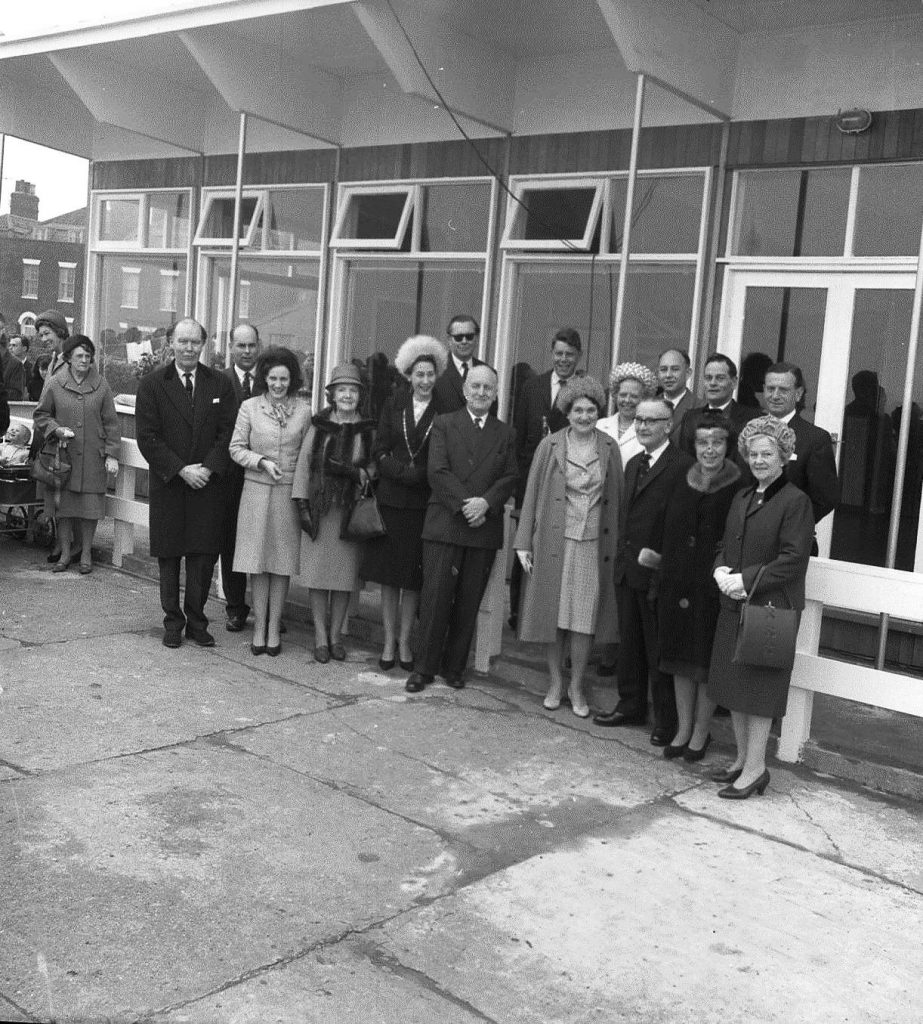
Official Opening 1964
The club’s new club house was formally opened, in 1964, some of the official party in the photo, left to right: Mr Julian Risdale, M.P., Mr, John Lovely, club secretary, Mrs Risdale, Mrs Tulloch, the Mayoress, Mrs. H. Gochin, Mr. G. Otho-Briggs, vice commodore of the club, Mr. J.H. Brown, commodore. Mr. Jack Knights, Olympic yachting star who opened the club, Mrs. J.H. Brown, Mrs Cowdell, Mr .E .Cann, rear commodore, the Mayor, Coun. H. Gochin, Mr T. Tulloch, club president, Mrs. Otho-Briggs, Mrs. E. Cann. Over the years the Club has produced some very good sailors. An early national champion was Brian Vincent in the Cherub class. Brian was an experienced sailor when the club was formed however two notable champions learned to sail in the Club, David Reason as National and International Champion in the Condor catamaran class and Andrew Webb as current National Champion in the Hurricane 5.9 catamaran class. Andrew has previously been European and National Champion on numerous occasions in that class. Racing is at the heart of developing good sailors and the Club’s season starts in April and finishes with the now traditional Boxing day Race, included in the programme there are the normal dinghy races with a few novelty events thrown in, as well as is a series of cruiser races in which the Club is joined by the Harwich and Dovercourt Sailing Club.
The Club has had its periods in the doldrums but is now once again a very vibrant club with a lively social side for the families and non-sailors. With the Youth training, under our own qualified RYA instructors, the future of the Club can only go from strength to strength.
(c) Harwich Town Sailing Club – http://Harwich Town Sailing Club
The Royal Harwich Yacht Club 1843 – 1939
Back in 1821 the proposed launching of the Essex Lifeboat at Harwich prompted the idea of a rowing and sailing regatta to mark the occasion. After two postponements of the launching the Regatta was rectified in 1828 when a full scale regatta was held in the honour of the Lord High Admiral, the Duke of Clarence. The success of this event ensured that regattas at Harwich would become an annual fixture. These regattas were organised by a committee at the Three Cups Hotel in Harwich rafter the regatta of 1843, decided to combine with local yachtsmen to form a yacht club. Thus on 28th September 1843 the bare bones of the Royal Harwich Yacht Club were laid albeit initially named the Eastern Yacht Club.
But despite a successful regatta the following year no progress had been made in the development of the club. Fortunately William Knight, a local yachtsmen, the nook charge of rapid reconstruction of the club. The club moved into the ready built premises in 1845 in the form of the ‘Baths and Clubroom’ which adjoined the Angel Gate Battery and the since demolished Ordnance Pier. The accommodation included reading and club rooms, a refreshment room, a keeper’s residence, and a range of rooms containing hot, cold, and shower baths. The rooms looked out across the entrance to Harwich Harbour, convenient for signalling between the club and the incoming yachts. Occasional dinners were still held at the Three Cups. There then followed periods of sojourn at the White Hart Hotel, the Pier Hotel and the Railway Buildings until 1865, when the Great Eastern Hotel was opened.
The Harwich Regattas began to attract the famous racing yachts of the late 19th century, and the like of the America’s Cup challengers Galatea and Valkyrie were to be seen battling it out in the races from Harwich Harbour. The use of the Great Eastern as club headquarters continued until after the Great War through the 1920s and 30’s during which time the Royal Harwich continued to attract the owners of the great racing yachts as both members of the club and as participants in the Harwich Regattas.
The whole town was able to enjoy the spectacle of the mighty “J” class yachts of Tom Sopwith and others creaming through the waters of the harbour and out to sea in classic yacht racing form. It was a sight which many people would never forget.
The Royal Harwich Yacht Club members were beginning to demand a permanent location of their club, preferably in the premises of their own. So in 1938 a subcommittee was set up to study the question of the provision of a clubhouse exclusive to Royal Harwich. Many options were considered for sites both in Harwich and up the Rover Orwell, including even an old paddle steamer lying at Pinmill which might be suitably converted. At last in March 1939, the decision was taken that the club premises would be best sited at Pinmill where most of the members were mooring their boats.
Then after the war in 1945 the matter was reopened with a new offer for a site made from Austin Farar, who had land available at the Cat House Yard at Wolverstone. The chance was too good an opportunity to miss, and by 1947 this option had been taken up, and the Royal Harwich Yacht Club moved to the permanent address at Wolverstone 1947/8.
Despite being a long way from Harwich by land, Woolverstone is not far by water. One day, perhaps, yachtsmen from the Royal Harwich Yacht Club will once again sail to Harwich and enjoy the delights of the historic port and town.
Bowling.
Dovercourt Bowling Club was founded in 1912. It was located on the seafront besides the Alexandra Hotel. This picture shows the opening of the indoor bowling at the Cliff Pavilion between the Mayor and the Deputy Mayor in 1938. Dovercourt also boasted a ‘pretty green adjoining the Alexandra Hotel’, but also had the ‘excellent bowling green’ of the Dovercourt Bowling Club Limited. This was claimed to be the principal feature of the district, having six rinks and being open to visitors at a nominal charge.
The Dovercourt Bowls Club played on a green at the side of the Alexandra Hotel until 1938, when it moved to the site near the Phoenix Hotel. Those playing on the green by the Alexandra Hotel are from left to right: “Bert” Allen, Commander Brown RN, George Smith, Johnson Cann, Mr Allen, The seated figures in the background are from left to right: Charles Hills (Mayor), Bert Sanders, Fred Sanders and Arthur Sanders, Frank Heslop.
The colonial building in the top right hand corner was known as the “German building” because it was built by a German during the 1930s. It later became the Elco café and was finally demolished to make way for Wimborne House. There are no white bowling mats, no white flat-soled shoes, no white clothing and no summer hats.
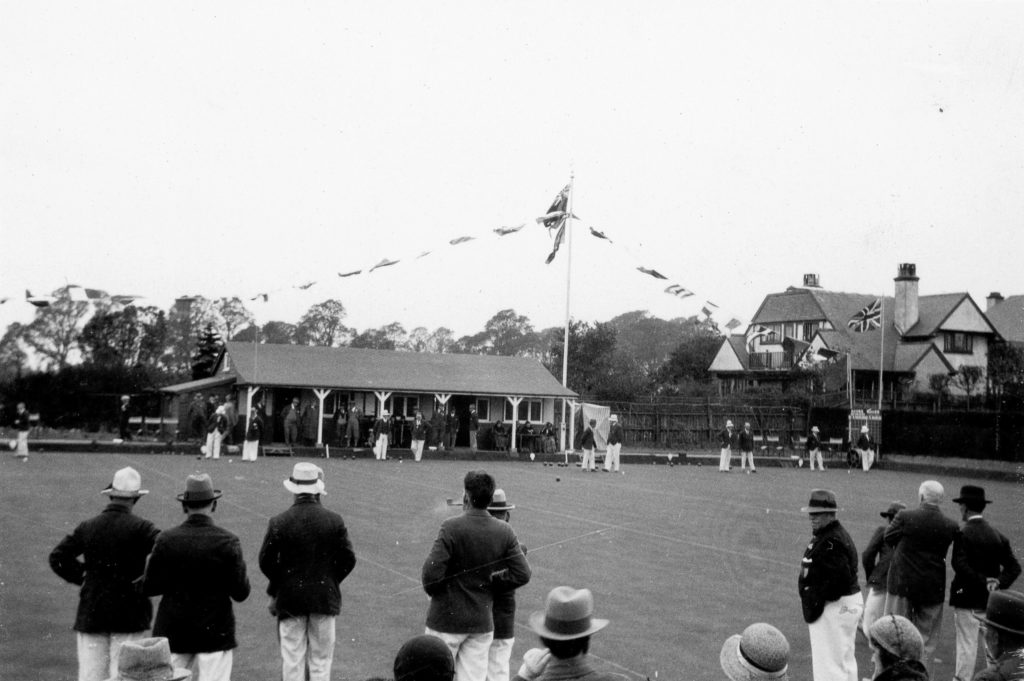
Bowling 1930’s
In the early 1930s prominent local business men acquired a piece of land at the bottom of Fronks Avenue. After extensive works they transferred the green from the sea front down to its present location. In 1938 a new Company was formed, ‘Dovercourt Bowling Club Ltd.’
Boxing
Harwich and Dovercourt Boxing Club was formed at the Old Corporation School in Harwich. Mike Barrago, local firemen and well-known amateur boxer, teachers some of the new recruits.
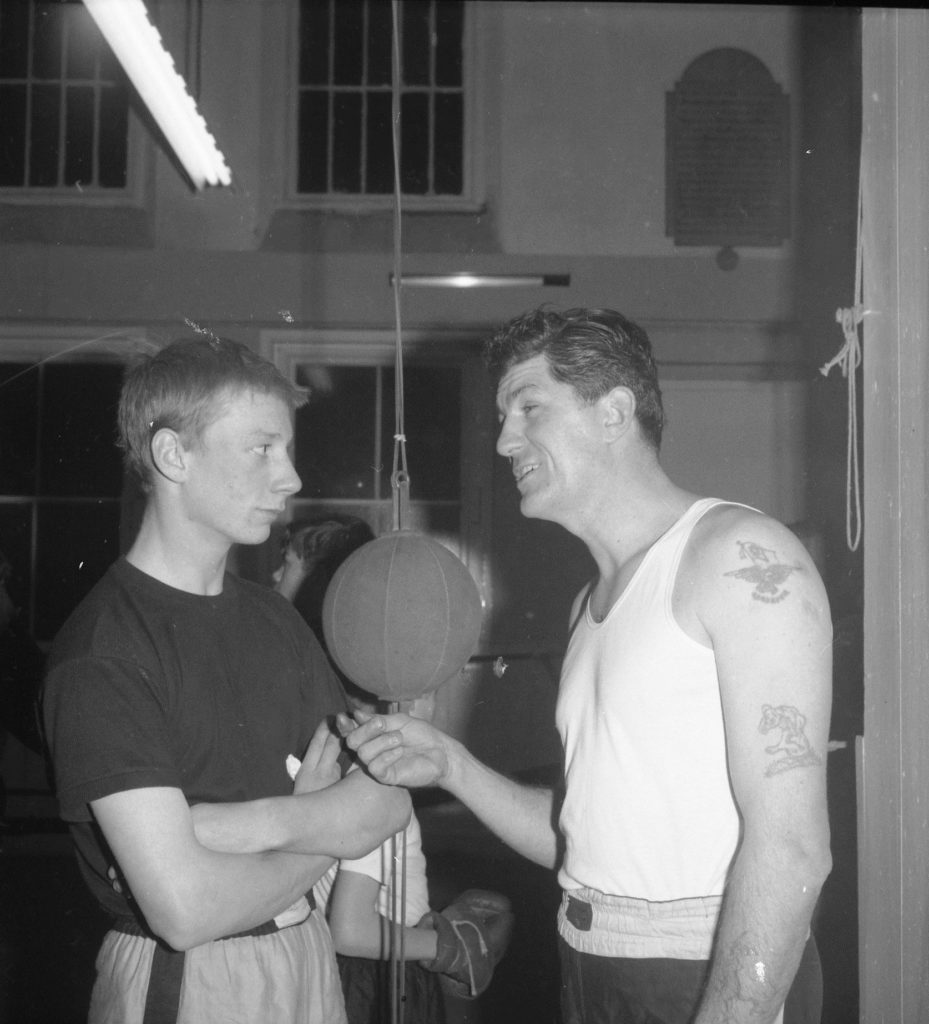
Dave Hill & Mike Barrago
The above picture taken at The Old Corporation School in 1966 shows Dave Hill & Mike Barrago, who was an ex ABA champion and used to train in the Hall at the back of the “Queens Hotel “.
Raft Race
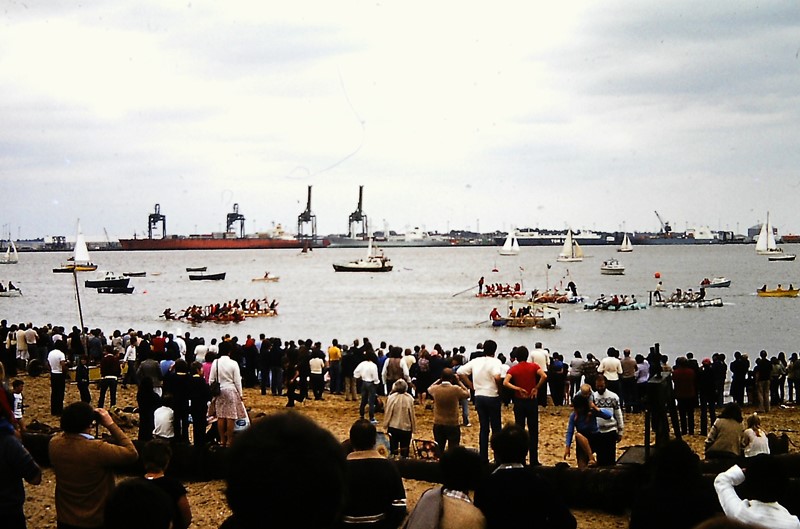
Raft Race
In 1978 Mike Roberts was approached by Dr. Duncan McPherson to organise a pulling races which were to be part of the 150th Harwich regatta Celebrations. Mike co-opted Richard Bunn with the organisation. Trinity house agreed to lend the boats and posters advertising the event were duly sent out. The following year Trinity house decided not to allow the use of their boats. So it was then that the idea of raft race evolved. and on the 22nd July 1979 the rafts turned up along with reliable helpers and judges.
From 1979 to the present year the raft race has continued to be an enjoyable family day out.
Sport over the years have affected modern popular culture and has often reflected changing social attitudes and standards.
Sports Gallery
Click “play” to start the gallery slide show.
We are adding more information to this site on a regular basis, if you wish to submit any photos or provide any information, please use the contact page at the bottom of the screen.
